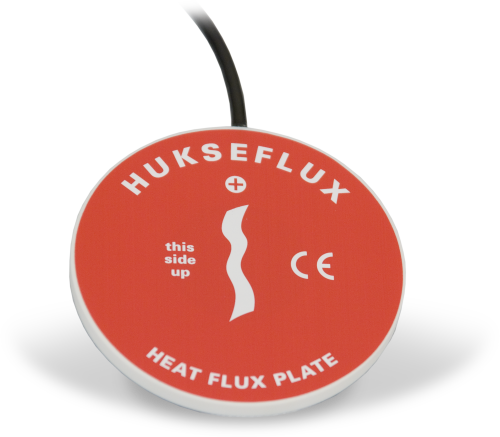
Ideal for energy-balance and Bowen-ratio systems






Resumen
El HFP01 mide el flujo de calor en el suelo, y es utilizado típicamente en sistemas de medida del balance de energía y en sistemas Bowen-ratio. Para disponer de un valor promediado espacial es habitual hacerlo con dos sensores. Si el medio es heterogeneo puede ser necesario utilizar sensores adicionales.
Leer másVentajas y características
- Compatible con la mayoría de nuestros dataloggers
- Compatible con interfaces serie CWS900, para usarse en redes de sensores inalámbricos
Imágenes



Descripción detallada
The HFP01 uses a thermopile to measure temperature gradients across its plate. Operating in a completely passive way, it generates a small output voltage that is proportional to this differential temperature. Assuming that the heat flux is steady, that the thermal conductivity of the body is constant, and that the sensor has negligible influence on the thermal flow pattern, the signal of the HFP01 is directly proportional to the local heat flux.
The HFP01’s output is in millivolts. To convert this measured voltage to heat flux, it must be divided by the plate’s calibration constant. A unique calibration constant is supplied with each sensor.
Preguntas frecuentes
Número de FAQs relacionadas con HFP01-L: 6
Expandir todoDesplegar todo
-
It depends on the sign convention used to describe heat flux through the wall. Heat flux that enters the red face and exits the blue face of the HFP01-L results in a positive analog output or positive heat. If the plate is already installed and it is desirable to use the opposite sign convention, change the sign of the multiplier to make it a negative value.
-
Yes, however, care must be taken to ensure a water-tight splice, such as by using an adhesive-lined heat shrink to cover the splice. This is important because splicing cable together increases the likelihood that water may enter the cable and cause shorting, corrosion, and some other potential issues, which can cause measurement issues.
Because of the potential issues, do not splice any sensor cable without first contacting Campbell Scientific to discuss the sensor in detail.
-
Because of the loss of IR radiation, nearly all thermopile instruments typically have a negative offset. This offset is most easily visible at night-time, when a small negative value is read instead of zero. This same offset is present during the daytime, but it is not as visible because of the large solar signal.
Another common issue involves leveling an instrument. Leveling a thermopile instrument can cause errors in the direct beam component because the cosine response is not correct. These errors are more notable when the sun is close to the horizon because the angle is so shallow.
-
The information included on a calibration sheet differs with each sensor. For some sensors, the sheet contains coefficients necessary to program a datalogger. For other sensors, the calibration sheet is a pass/fail report.
-
The HFP01-L uses a thermopile to measure flux across the plate. The output of a thermopile is proportional to the temperature gradient across the thermopile. The HFP01-L nominal calibration is 20 W m-2 /mV. The HFP01-L output voltage will depend on the temperature gradient (flux) across the plate.
-
To incorporate a sensor that is compatible with wireless sensor interfaces into a wireless network, a CWS900-series wireless sensor interface is needed, as well as an A205 CWS-to-PC interface to configure it.
Especificaciones
| Sensor Type | Thermopile |
| Sensitivity | 50 μV W-1 m-2 (nominal) |
| Nominal Resistance | 2 Ω |
| Rango temperatura | -30° to +70°C |
| Sensor Thermal Resistance | < 6.25 x 10-3 K m2 W-1 |
| Rango de medida | ±2000 W m-2 |
| Expected Typical Accuracy | Within -15% to +5% in most common soils (12 hour totals) |
| Plate Diameter | 80 mm (3.15 in.) |
| Plate Thickness | 5 mm (0.20 in.) |
| Peso | 200 g (7.05 oz) without cable |
Documentos
Folletos producto
Casos de aplicación
The Utah Geological Survey, supported by the Utah Division of Water Rights, has constructed a......leer más
International partnerships for sustainable innovations Improved water use in agriculture is essential to successfully adapt to......leer más



